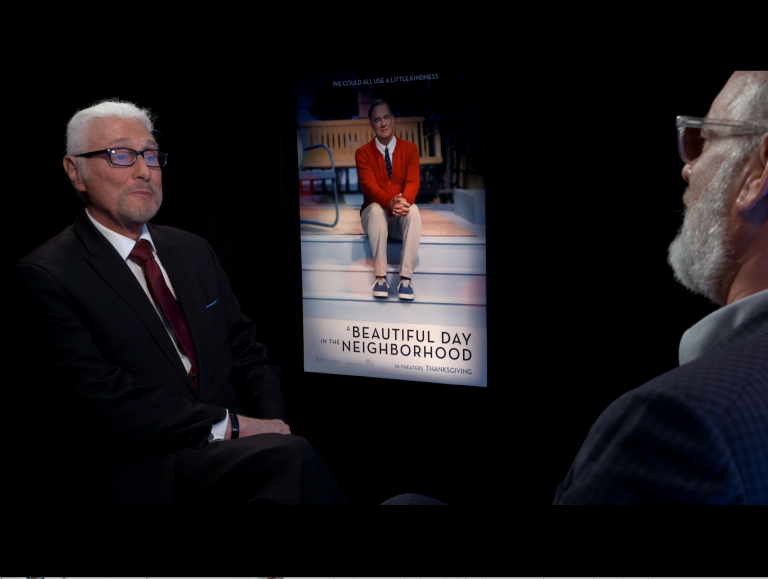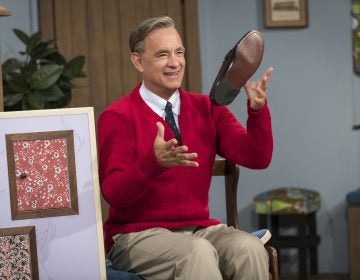New Mr. Rogers film pushes superstar actor Tom Hanks to take a risk
Patrick Stoner interviewed the Oscar winner about portraying the PBS children’s TV legend. Here’s a conversation with WHYY’s Jennifer Lynn about that chat.
Listen 5:49
Film critic Patrick Stoner (left) interviews Tom Hanks (right) for his movie, "A Beautiful Day in the Neighborhood," where Hanks plays Fred Rogers. (Flicks)
The film “A Beautiful Day in the Neighborhood,” starring Academy Award-winning actor Tom Hanks, opened in theaters Friday.
Hanks sings and brings heart to his role as beloved television icon Fred Rogers, who treasured connection with children and adults on and off the set of “Mr. Rogers’ Neighborhood,” the PBS-produced educational show he hosted for 33 years. Rogers died in 2003.
WHYY’s Patrick Stoner, movie critic and host of “Flicks,” asked Hanks this week how he handled the role. Morning Edition host Jennifer Lynn asked Stoner about that conversation, and to pare down what the story is about.
—
Patrick: It’s a story of kindness, and everybody wanted to know what made Mr. Rogers so kind. And was he really so kind?
Jennifer: Tom Hanks did a ton of research to prepare for this role.
Patrick: Oh, he watched so many “Mr. Rogers” episodes. You know how many were made? He just watched a ton of them. Then, of course, there was an award-winning documentary earlier this year. He studied that, and he was surrounded by people from his widow to the person who played Mr. McFeely, Officer Clemens, all the people who worked on the set. So many people who knew Mr. Rogers and can report on it directly. He did all of that and much more, I’m sure.
Jennifer: Yeah. And you asked Tom Hanks about how he approached his role. We have a clip from that conversation.
—
Patrick: Impressions are not acting. What is the significant difference?
Hanks: There is an essence that you’re trying to get, as opposed to an appearance you’re trying to emulate. Mari Heller, the boss, the director of the film, said essentially, ‘You are going to have a wig, and you’re going to have some eyebrows. The rest is up to you.’
—
Jennifer: Tom Hanks had a lot of freedom in that role.
Patrick: Tom Hanks is Tom Hanks, he’s a superstar, and therefore he could play it pretty much any way he wanted to. He didn’t just want to do an impression. And that, of course, was the most important thing. He wanted to find the man inside, and then let you see the outside but know more about him.
Jennifer: You saw “A Beautiful Day in the Neighborhood.” Does he really get that essence?
Patrick: He does. Now you’re going to get people who are saying, well, of course he does. He’s Tom Hanks. He was so much like Mr. Rogers, just typecasting. But there are actually many differences, and they’re in the nuance. One of the things that people forget is that most of what really good professional actors do can only be seen by other people in the business who can see what they’re doing. Because frankly, if you could see exactly what they were doing, they weren’t doing it quite good enough.
Jennifer: There’s this characteristic of Mr. Rogers that so many of us are familiar with, the way he’d look at the camera.
Patrick: He was hardly your typical TV person, was he? And yet he’s the only icon that you can mention that has survived and will survive beyond all of us, including Tom. And that is because he had an ability with his eyes to look through that camera at people. But he also did it when he was talking to people. And even when he was talking to a gorilla, Koko.
Jennifer: Well, here’s Hanks talking about being directed to stare into the camera. To do that thing that Fred Rogers did so well, connect with his audience, especially children.
—
Hanks: It was frightening.
Patrick: How about that?
Hanks: It was the longest minute of my professional career with the cameras rolling. Part of this cinematic storytelling process, part of the movie we’re making, part of the performance that we’re giving. For me to look down the barrel of a camera at somebody that was not a 2-year-old on the other side.
—
Patrick: There’s the social media line: What is the most difficult one minute professionally for Tom Hanks?
Jennifer: Stunning how such an esteemed actor is doing something new.
Patrick: All professional actors are trained to pay no attention to the camera, and they get very, very good at it. To force them to look into the camera, acknowledge it’s there, and treat it like you’re talking to somebody through it — that, they’re not trained to do. And that includes the best. As a matter of fact, it especially includes the best.
Jennifer: Patrick, that’s something you do at the end of every “Flicks.” You look into the camera, and you say …
Patrick: Well, I’m Patrick Stoner. But what I really could be saying is, I’m no Tom Hanks.
Jennifer: Ah, but we cherish you nonetheless.
Patrick: Thank you, Jennifer.
Jennifer: Thank you, Patrick.
WHYY is your source for fact-based, in-depth journalism and information. As a nonprofit organization, we rely on financial support from readers like you. Please give today.





